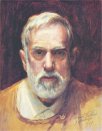- Home
- Resurrection ▾
-
Learn ▾
- Free library
- Glossary
- Documents
- Initiation
-
Shaped fabrics
- Introduction
- Popularization
- Definitions
- Le métier de façonné
- Principes du façonné
- Mécaniques de façonné
- Le jeu des crochets
- Les cartons
- Chaîne des cartons
- Mécanique 104 en détail
- Pour en finir
- Montage façonné
- Empoutage 1/3
- Empoutage 2/3
- Empoutage 3/3
- Punching, hanging and dip
- Autres façonnés
- Façonnés et Islam
-
Cours de tissage 1912
- Bâti d'un métier
- Le rouleau arrière
- Les bascules
- Formation du pas
- Position de organes
- Mécanique 104 Jacquard
- Fonctionnement 104
- Lisage des cartons
- Le battant du métier
- Le régulateur
- Réduction et régulateur
- Mise au métier d'une chaîne
- Mise en route du métier
- Navettes à soie
- Battage
- Ourdissage mécanique
- Préparation chaînes et trames
- Equipment ▾
- Chronicles ▾
- Fabrics ▾
- Techniques ▾
- Culture ▾
- Language ▾
Fabrics, lamps, models, dresses, some of the creations Mariano Fortuny
Mariano Fortuny y Madrazo was born in 1871 in Granada, Spain. His father, Mariano Fortuny y Marsal, was also an eclectic painter and collector of ancient oriental fabrics and carpets, ceramics and coats of arms.
His father died when he was only three years old and his mother, who was also very involved in art, decided to move the whole family to France, in Paris, where Mariano later began to paint.
Then, in 1889, the family moved to Venice, Italy, and Mariano Fortuny y Madrazo established his laboratory workshop in a magnificent Palazzo Pesaro Orfei, later to be called the Palazzo Fortuny, now the Museum Fortuny.
Mariano Fortuny y Madrazo died in his Venetian palace in 1949 and was buried in the Verano Cemetery in Rome.
Mariano Fortuny has dedicated his life to Art: he has been an excellent designer of clothes and fabrics, but has also been interested in many artistic disciplines, such as interior design and scenography, painting, Photography, architecture and the creation of lamps.
Fortuny has also invented new textile dyeing methods and fabric printing processes, reproducing the depth, color and beauty of old tapestries, brocades and velvets.
A creative and incomparable artist, at the end of the 19th century, he experimented with the use of electric light, scarcely invented, in scenography and worked with the illustrious Italian writer Gabriele D'Annunzio.For interior decoration, he created the elegant Fortuny lamps, which diffused a subtle light through opalescent silk shades, stretched over delicate metallic structures. The lamps were made of silk hand-painted with gold motifs inspired by Oriental art and decorated with small glass beads and silk cords.
In the early 1900s, Mariano Fortuny y Madrazo was attracted by new styles and new creations in textiles and fashion, by the new aesthetics and functionalism concepts developed by reformers of applied arts, such as the English designer William Morris or the painter E. Burne-Jones, as well as their theories on a modern style, freed from traditional constraints and conventions.
During these years, Fortuny created the famous "Knossos Scarf", his first fashion garment, made of silk, square and printed with geometric or asymmetrical patterns.
In 1907, Fortuny created her most spectacular dress: the Delphos Dress in folded silk, rendered illustrious by the legends of the theater, Isadora Duncan and Sarah Bernhardt. Drawn in a revolutionary form, inspired by the clothes of ancient Greece, the long dress was both simple and broad, artistic and functional; The hems were adorned with Venetian colored glass beads, with a decorative function but also functional.
All the pleated and printed silks, all dresses and scarves were made in his studio, as well as multi-colored velvet, satin trim and silk belts and belts.The Fortuny dress in pleated silk
Before being shaped, the bristles were dyed in all imaginable colors, in different shapes and combinations of colors and changing according to light and movement.His achievements were inspired by the floral motifs of the Ottoman fabrics, the luxurious embroideries of the Renaissance, as well as the abstract designs and vibrant colors of Persian Art.
The great French writer, Marcel Proust, wrote this about the Fortuny dresses:
"Of all the interior or exterior dresses worn by Madame de Guermantes, those which seemed most likely to correspond to a well-defined intention, those which seemed to have to be endorsed with a special meaning, were the dresses created by Fortuny y Madrazo at It is their historical character, or earlier the fact that each of them is unique, which gives them that special significance, that the pose of the woman who wears it while she is waiting for you Or she speaks to you, seems to assume exceptional importance ...? "
Fortuny y Madrazo created the pleated silk dresses, velvet scarves, fabrics and the most remarkable and timeless garments of his time. Still very fashionable today, the way the pleated end of the silks was made remains still a mystery. The scarves allowed a great freedom of movement to the body of the woman and were realized with the intention of uniting the form and the fabric.
Their beauty lies in the elegant simplicity, the perfect cut, the superior quality of the materials, the richness and the sensuality of the colors. All these elements, perfectly integrated with each other, contribute to elevate the Fortuny garment to the rank of "work of art".

Mariano FORTUNY Y MADRAZO(1871-1949)
Spanish artist, creator of dresses and fabrics
Mariano Fortuny y Madrazo was one of the most creative artists of his time. He has worked mostly in Italy and has known his greatest reputation thanks to his creations of Art Nouveau textiles, such as dresses in finely pleated silk and his refined scarves in shiny silk and velvet.